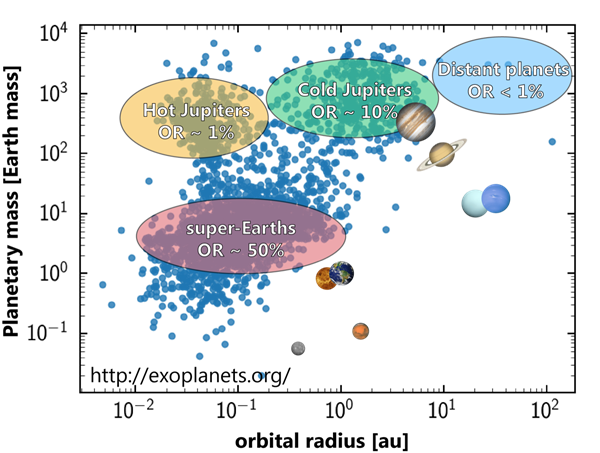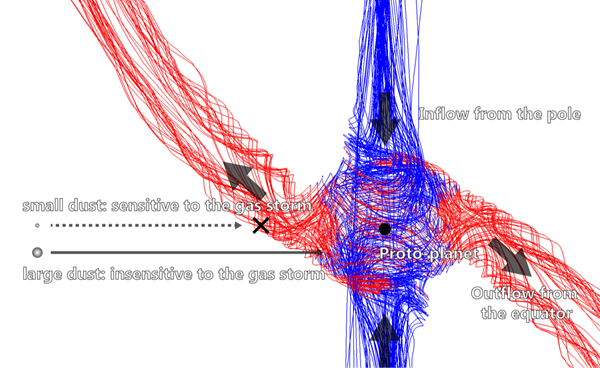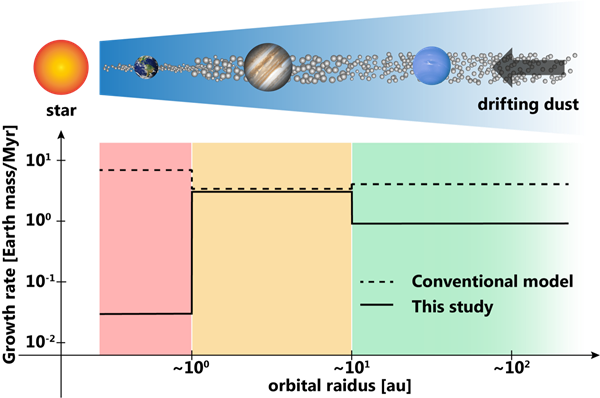Ayumu Kuwahara (2nd-year Master’s student, Tokyo Institute of Technology) and Dr. Hiroyuki Kurokawa (Earth-Life Science Institute, Tokyo Institute of Technology) have proposed a theory that planetary seed-induced gas storms determine the appearance of planetary systems.
Recent advances in exoplanet observations have found non-uniformity in their distribution, which remains a mystery in planet formation theory.
This study provides a natural explanation for the non-uniformity of exoplanetary systems, as well as the architecture of the Solar System, which will be an important part of understanding how habitable planets like Earth form.
Background: non-uniformity in the distribution of the Solar System and extrasolar planets
Since the first exoplanet orbiting a solar-type star was discovered in 1995, the number of confirmed exoplanets has now reached around 4000. When exoplanets are arranged with respect to the distance from their host stars (Figure 1; hereafter central star), their distribution is shown to be non-uniform. Small planets are abundant in the region close to the central stars, whereas large planets are abundant in the distant region. The Solar System has similar non-uniformity: inner small plane
ts (such as Earth), and outer large planets (such as Jupiter). Planets form in protoplanetary discs, which consist of gas and dust, around young stars. The dust grows through mutual collisions. In the final stage of the planetary growth process, the planetary seeds grow rapidly via accreting millimetre- to centimetre-sized dust particles. This is the manner in which planetary systems appeared. However, the origin of the non-uniformity in (exo)planet distribution remains a mystery in planet formation theory.

Results: planetary seed-induced storms have determined the architecture of planetary systems
This study has succeeded in giving a natural explanation for the non-uniformity of (exo)planets. The researchers have conducted numerical simulations of the gas flow and the dust motion in a protoplanetary disc using a super computer, and combined the simulation results with the inference of the size distribution of dust in a protoplanetary disc suggested by the latest theoretical/observational studies. The dust experiences friction from surrounding gas and smaller particles of dust are more sensitive to the gas flow. This study showed that a planetary seed disturbs the surrounding gas with its gravity and creates a gas storm (Figure 2). In addition, this study found that the gas storm interferes with the accretion of small dust particles onto the planetary seed. Rocky dust particles in the region close to the central star are non-sticky, and therefore remain small even if they collide with each other. In this region, the growth of planetary seeds is slow because the gas storm prevents small dust particles from accreting onto the seeds. On the other hand, ice-covered dust particles in the region distant from the central star are sticky and grow larger. These particles can accrete onto the planetary seeds because the gas storm’s effects on them weaken as they grow larger. The researchers calculated the growth rate of planetary seeds at various locations in a protoplanetary disc. They revealed that small planets between Earth-mass and super-Earth-mass are formed in the region close to the central star, whereas large planets between Neptune-mass and Jupiter-mass are formed in the distant region (Figure 3). This study proposed a possible scenario that can simultaneously explain the non-uniformity of the distribution of exoplanets and the architecture of the Solar System.


Future developments
Recent observations have identified potential habitable planets which can retain water in a liquid state. How did the habitable planets—including Earth—obtain water, and how much water was supplied to them? These questions are important in planetary science. This study showed that the differences in planetary seeds’ growth rate at different locations in a disc determine the appearance of planetary systems. By considering the differences in water supply at the different locations in a disc and the effect of migration of planetary seeds during their growth process, this study will develop into a more realistic theory of formation of planetary systems in the future.
| Journal | Astronomy & Astrophysics |
| Tile of the paper | Influence of protoplanet-induced three-dimensional gas flow on pebble accretion – Ⅰ. shear regime |
| Authors | Ayumu Kuwahara1,2, Hiroyuki Kurokawa2 |
| Affiliations |
1. Department of Earth and Planetary Sciences, Tokyo Institute of Technology 2. Earth-Life Science Institute, Tokyo Institute of Technology |
| DOI | 10.1051/0004-6361/201936842 |
| Online published date | January 15, 2020 |
